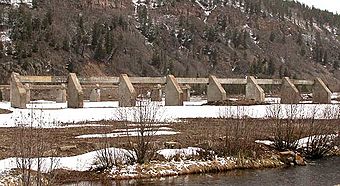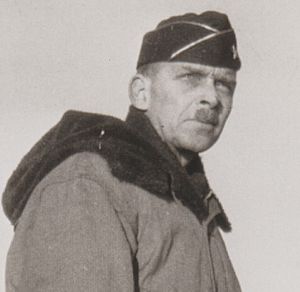Camp Hale facts for kids
Quick facts for kids |
|
|
Camp Hale Site
|
|

Concrete ruins of the field house
|
|
| Location | Eagle County, Colorado, USA |
|---|---|
| Nearest city | Red Cliff, Colorado |
| Built | 1942 |
| Architect | U.S. Army |
| NRHP reference No. | 78003522 |
| Added to NRHP | 10 April 1992 |
Camp Hale was a special training base for the U.S. Army in Colorado. It was built in 1942 in the Eagle River valley. This camp was created to train soldiers for the 10th Mountain Division.
The camp was named after General Irving Hale. It was located very high up, about 9,200 feet (2,800 m) above sea level. Soldiers at Camp Hale learned important skills. These included mountain climbing, skiing (both Alpine and Nordic styles), and how to survive in very cold weather. They also trained with different weapons. When the camp was fully active, about 15,000 soldiers lived and trained there.
The idea for a special ski corps came from a national effort. Groups like the National Ski Patrol and local ski clubs helped out. Even Hollywood played a part in getting people interested. Enough men joined to form three army regiments. After their training, these soldiers were sent to fight. Camp Hale closed down in November 1945.
Contents
Camp Hale in World War II
Building a Special Training Camp
The idea for a U.S. ski army came from the Finnish army. They used ski warfare tactics during the Winter War (1939–1940). At first, 8,000 skiers and outdoor experts were recruited. The camp was built to support this effort. It cost about $30 million to construct.
The War Department chose this location for several reasons. It was high up at 9,200 feet (2,800 m). The Denver and Rio Grande Western Railroad had a stop nearby. Also, the Tennessee Pass area usually got a lot of snow. Construction of Camp Hale started in the spring of 1942. It was finished just seven months later.
During construction, Highway 24 was moved. A new sewage system was put in to protect the nearby town of Red Cliff. The wet meadow area was also drained. The camp had many buildings. These included places to eat, medical centers, a ski shop, and offices. There was also a movie theater and stables for animals.
White barracks were built in straight lines for 15,000 soldiers. However, when the first trainees arrived in the winter of 1942, only a few barracks were used. These first soldiers were from the 87th Regiment. This group was part of the 10th Light Division, which was soon renamed the 10th Mountain Division. The War Department needed more skiers for this special fighting group. They asked the American Ski Patrol Association to help. This group contacted ski clubs and schools across the country. Each person who wanted to join had to provide three letters of recommendation.
Finding New Recruits
After 1942, it became harder to find new recruits because of the war. But then, Darryl Zanuck released a movie called Sun Valley Serenade. It starred Sonja Henie and the Glenn Miller Orchestra. The movie was filmed in Sun Valley and was very popular. This Hollywood effort helped to get more people interested in joining the ski corps.
Two more movies were filmed at Camp Hale during the war. These movies showed the special white-clad troops. They were called Mountain Fighters (1943) and I Love a Soldier (1944). The ski corps was also featured on national magazine covers and popular radio shows. These efforts helped bring in enough recruits to add the 86th and 85th Regiments. This made the 10th Mountain Division a full division.
However, recruiters soon realized there weren't enough skiers to fill all the new regiments. So, they started looking for all kinds of tough outdoor people. Their new slogan was that the 10th Mountain Division was made up of "college boys to cowboys." Also, 200 women from the Women's Army Corps joined to help with office work.
Training at Camp Hale
By 1943, about 14,000 men were training at Camp Hale. Conditions at the camp were tough. The high altitude made it hard to breathe at first. The valley also trapped smoke from the coal used for heating. This created polluted air. There wasn't much to do for fun because the camp was so isolated. Even the USO couldn't visit often. Many soldiers who weren't skiers didn't enjoy the skiing training.
Soldiers learned to ski at Cooper Hill. Ski instructors from places like Sun Valley taught them. Cooper Hill was three miles (5 km) south of the camp. It had barracks for the instructors and a new T-bar lift for the trainees.
Besides the 10th Mountain Division, other groups also trained at Camp Hale. These included the 38th Regimental Combat Team and the Norwegian-American 99th Infantry Battalion. Soldiers from Fort Carson also came for mountain and winter warfare training. Trainees learned skiing, mountain climbing, and how to survive in snow. This included building snow caves. They also practiced winter combat skills.
Camp Hale was only active for three years. It closed in November 1945. The 10th Mountain Division then moved to Texas.
Prisoner of War Camp
Camp Hale also held about 400 German prisoners of war. These were soldiers from Field Marshal Erwin Rommel's Afrika Korps. In February 1944, a guard named Private Dale Maple helped two German sergeants escape. They were caught in Mexico and returned to U.S. authorities. In a separate event in March 1944, five WACs were accused of exchanging notes with the prisoners. Three of them received sentences and were discharged from the army.
Camp Hale in the 1960s
During the 1960s, the CIA secretly trained Tibetans at Camp Hale. The first group of 135 Tibetans arrived by February 1963. The site was chosen because its mountains were similar to the Himalayan Plateau. The Tibetans called the camp "Dhumra," which means "The Garden."
The CIA spread a story that Camp Hale would be used for atomic tests. This made it a high-security zone. The entire area was blocked off and patrolled by military police until the camp closed in 1964. In total, about 259 Tibetans were trained at Camp Hale. After the camp was closed, no Tibetans stayed in Colorado. From 1958 to 1960, Anthony Poshepny also trained other special teams there. These teams included Tibetans and Hui Muslims for missions in China.
In 1965, Camp Hale was taken apart. The land was then given to the U.S. Forest Service. Since 1974, the area has been used as a youth development training center. An organization called SOS Outreach uses the site. They help young people learn outdoor skills, similar to what the 10th Mountain Division soldiers experienced.
In 1962, Pete Seibert founded the Vail Ski Resort nearby. He was one of the soldiers who trained at Camp Hale and returned to the area after the war.
Camp Hale Today
In 2003, the U.S. Army Corps of Engineers started a cleanup project. They are working to remove unexploded ordnance (old bombs or shells) from the site. This cleanup is still happening today.
Most of what remains of Camp Hale is now part of the White River National Forest. There are camping areas where people can stay overnight on this former army base. Several signs with historical information are placed around the area. These signs tell about the camp's construction, the 99th Infantry Battalion, ski training, and other activities.
There is a proposal for the Camp Hale site to become the first National Historic Landscape. If this happens, it would protect the larger Camp Hale area, not just the main camp valley.
Images for kids





